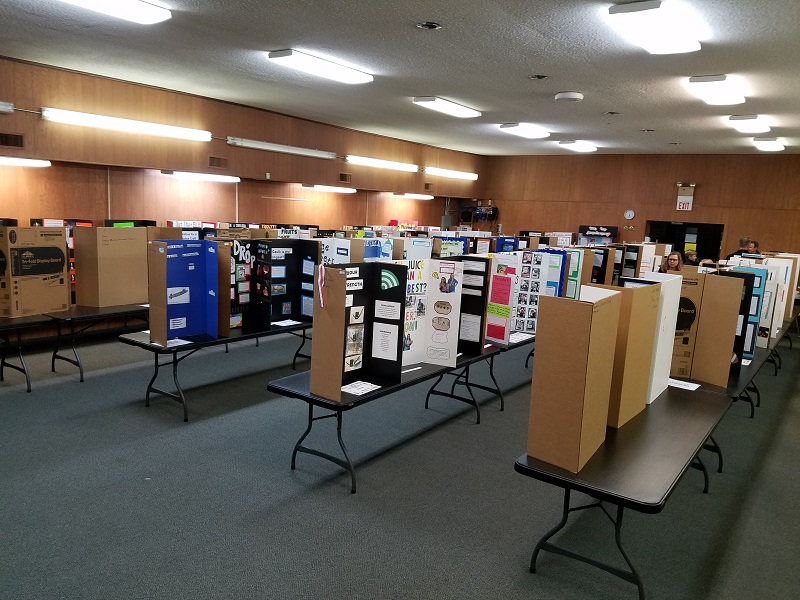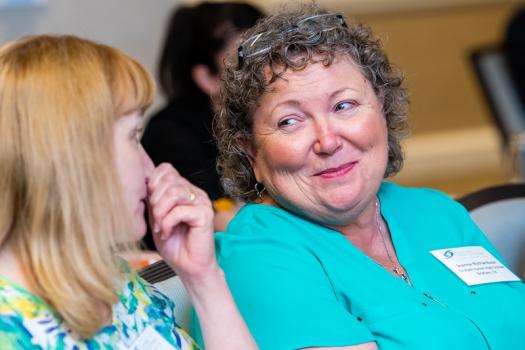Advocate Program, STEM Outreach
One teacher shares her blueprint for a successful science and engineering fair

Students, project boards, judges, nerves and excitement—all the makings of a science fair, but how does it all come together? We recently talked to Jeanne Richardson, a science teacher from Graham Junior High School in Texas who recently launched a science fair at her school. Jeanne was named a Society Advocate in 2018. Through the program, Jeanne mentors a cohort of eight underserved students in an after-school club called the Science Research Team. She guides these students in their science research and helps them to apply to science competitions, giving them a chance to fulfill their potential.
Jeanne decided to take her Advocate duties one step further and organized the school district’s first sanctioned science and engineering fair for all grades to participate in. While the feat has by no means been easy, seeing how her students have greatly benefited from the experience have made her efforts worthwhile.
Why did you decide to start your school district’s first science fair?
Junior high has been sponsoring a 7th Grade Science Fair for many years, but this was the first year we held a District Science and Engineering Fair following all of the requirements for a sanctioned science and engineering fair. I had insisted that we hold a science fair that counted and that we find a sanctioned fair for our students to participate in.
What were some of the planning challenges?
When we started, we had no idea what the rules or categories were or how to help prepare the students for a competition. I decided to attend a training session in Fort Worth with another teacher from our school, which helped answer many of our questions and helped get us started.
The scientific method is the basis for all science, so it seemed logical to me that advanced science students participate in a fair. I learned quickly that requiring other teachers to participate is not the best approach. They all have great ideas to offer and it’s better to ask for their input. After assembling a team of teachers, we had over 100 projects in our first sanctioned science fair, including projects from sixth, seventh and eighth-grade students. They did a great job and we will continue to raise the bar next year.
How have other teachers supported you in making the science fair possible?
All of the science teachers in my department had entries in our science fair. Every teacher with advanced students helped them get ready for the fair. My Lead Advocate from the Society for Science & the Public has been such a great mentor during this process. She has listened and offered great advice.
How would you recommend another teacher approach starting a school science fair?
First I would talk it over with the administration. Get them on board with your plans. Talk to the other science teachers. Get their ideas about the program. You can’t do it alone and need their help and cooperation. Talk to the head of your department and make sure you have the costs associated with a local show included in the budget, or find other funding. At the least, you will have the cost of awards.
What is your connection to the judges you invited?
I reached out to our regional education office for suggestions. They helped to recruit two judges who had experience at regional and state fairs. They did an outstanding job interviewing students; they also gave me great advice on how to improve our fair next year. I was glad to have judges with experience with science fairs rather than only scientists from our local area. These judges had no connection to any of the students. I think our judging was totally impartial and fair to all.

What is your favorite memory from the science fair?
My favorite memory was listening as students were interviewed by the judges. It was an amazing experience as a teacher to listen to my students get so excited explaining what they did, how they came up with their idea and explaining their biggest trials and victories. Even my most quiet student became animated when he was explaining his theory to the judges. They were in their element, explaining the science behind their idea and getting so excited about. That is as good as it gets!
What changes have you seen in your students since their participation?
CONFIDENCE. I have watched these students who asked in the beginning, ‘Why did you pick me?’ grow in confidence during the year. They now have the attitude of being the lead scientists in our school because they are a part of the Science Research Team. It is one very cohesive team; no one considers who is smartest, coolest, the color of skin, rich or poor, popular or not. They all just think of each other as part of a team where they can be nerdy and it is OK.

What is your hope for the future of your students?
I want my students to understand the scientific method. I want them to understand how scientists work to make a difference in our world. My biggest hope is that every one of my students will understand the world they live in a little better, and hopefully care enough to try to make it a better place.
There is one student in particular that I would like to tell you about—7th grader, AAliyah. When she first joined my team, she questioned why I chose her. Over time, she has progressed from not knowing if she really liked science to being a student who has applied to attend a summer camp for future marine biologists. The fact that she now is looking into a STEM career seriously is a big difference.The Advocate Grant Application is now open. Please apply here.


